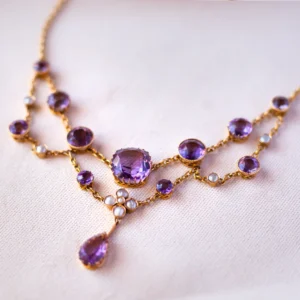Silver has long been cherished across the world not just for its beauty, but for its deep cultural meanings. From ceremonial uses to everyday adornments, silver holds symbolic value that varies from one culture to another. Marcasite jewelry

Cultural Significance in India: Purity and Ritual
In India, silver symbolizes purity and spirituality. It’s commonly used in religious ceremonies, weddings, and traditional gifts. Silver anklets, toe rings, and utensils are often given to newborns or used during sacred rituals to signify protection and blessing.
China: Wealth and Protection
In Chinese culture, silver represents wealth and safety. It is traditionally gifted during festivals and weddings, especially in the form of jewelry for babies and brides. Many believe silver jewelry protects against negative energy and maintains physical well-being. This reflects the cultural significance of silver in promoting harmony and health.

Thailand: Craftsmanship and Heritage
Thailand is known for its exceptional silver artisanship, particularly in regions like Chiang Mai. Silver jewelry here often showcases intricate designs inspired by local flora, mythology, and tribal symbols. It’s a vital part of both cultural identity and the country’s export economy, reinforcing its cultural significance in preserving heritage.
Mexico: Pride and Artistry
Mexican silver, especially from Taxco, is renowned for its craftsmanship. Jewelry pieces often feature indigenous motifs and bold, sculptural forms. Silver is not only a fashion statement but a symbol of national pride and creative expression, highlighting its cultural significance in the arts.
Africa: Status and Ceremony
In many African communities, silver is associated with social status and used in traditional ceremonies. Necklaces, bangles, and headdresses made of silver are worn during weddings, initiations, and festivals to signify rank, wealth, and community roles illustrating its strong cultural significance in societal rituals.
Middle East: Elegance and Faith
Silver is a favored metal in many Middle Eastern cultures due to its association with modesty and refinement. It’s frequently used in Islamic art and jewelry, often engraved with verses or blessings, and worn as a sign of faith and beauty, underscoring the cultural significance tied to religion and aesthetics.

Western Cultures: Fashion and Function
In Europe and North America, silver is appreciated for both its aesthetic and functional qualities. It’s used in everything from casual wear to luxury fashion, often symbolizing sophistication, modern style, and personal expression. Here, the cultural significance of silver lies in its role as a timeless fashion element.
Silver’s cultural significance is vast and varied. Whether worn for protection, celebration, or artistic identity, silver jewelry connects people to their heritage and beliefs. Understanding these cultural roots adds depth to each piece, making silver more than just a precious metal; it’s a global symbol of meaning and tradition.

Vintage-inspired silver jewelry adds character and timeless charm to your daily outfits. Whether you’re dressing for the office, brunch with friends, or a casual weekend, these pieces offer subtle elegance without overwhelming your style. They are perfect for those who love a blend of classic and contemporary design. Marcasite jewelry

What Makes Silver Jewelry Vintage-Inspired?
Vintage-inspired silver jewelry typically features:
- Intricate filigree or engraved patterns
- Oxidized finishes to simulate age
- Marcasite accents and antique settings
- Classic motifs like flowers, scrolls, or Art Deco geometry
These design elements evoke a sense of history while remaining suitable for modern fashion.
Everyday Silver Jewelry Staples
For daily wear, look for the following timeless pieces:
- Stud earrings: Simple silver or marcasite studs pair well with any outfit.
- Delicate silver rings: Choose slim bands with vintage engravings or gemstone accents.
- Pendant necklaces: Go for lockets or oval charms with intricate borders.
- Bracelets: A slim silver bangle or chain bracelet with vintage flair adds polish to any look.
These items are easy to wear and work with both casual and business attire.

How to Style Vintage Silver Jewelry Daily
Styling vintage-inspired silver jewelry is about balance:
- Keep it minimal: Pair one or two vintage pieces with neutral clothing to avoid over-accessorizing.
- Layer smartly: Combine a vintage pendant with a simple silver chain for depth.
- Mix old and new: Blend modern silver earrings with a vintage-inspired bracelet to create contrast.
This approach keeps your look modern while honoring vintage aesthetics.
Benefits of Wearing Silver Jewelry Every Day
- Durability: Sterling silver is strong enough for everyday use.
- Skin-safe: Hypoallergenic options are great for sensitive skin.
- Timeless style: Vintage-inspired silver jewelry doesn’t go out of fashion.
These factors make silver jewelry a practical choice for daily accessories.

Where to Shop for Vintage-Inspired Silver Jewelry
You can find vintage-inspired silver jewelry at:
- Online jewelry boutiques with vintage collections
- Local artisan markets or antique fairs
- Wholesale jewelry retailers that specialize in marcasite jewelry or sterling silver
Look for craftsmanship, authenticity, and clear product descriptions to ensure quality.
Vintage-inspired silver jewelry offers an elegant solution for everyday style. Whether you love the look of antique finishes, delicate details, or marcasite sparkle, these pieces elevate your outfit while staying wearable. Embrace the charm of the past with silver jewelry that’s made for the present.

Silver jewelry remains a timeless favorite among young women for its versatility, affordability, and trend-forward styles. Whether dressing up for a night out or keeping it casual, silver pieces offer the perfect finishing touch. Here are the top five silver jewelry designs that are currently winning hearts among young fashion enthusiasts. Marcasite jewelry

1. Minimalist Silver Rings
Sleek and subtle, minimalist silver rings are perfect for everyday wear. These designs include thin bands, stackable rings, or geometric shapes. Young women love them for their effortless charm and the ability to mix and match for a personalized look.
Style Tip: Stack several thin silver rings on one hand for a modern, layered effect.
2. Dainty Silver Necklaces
Lightweight and delicate, dainty silver necklaces are a staple in any young woman’s jewelry box. Popular styles include small pendants, initial charms, and fine chain chokers. These pieces pair well with casual tops, dresses, or even office wear.
Popular Picks: Heart pendants, star charms, and personalized name necklaces.

3. Silver Hoop Earrings
Silver hoops are a bold yet classic choice. Young women are embracing small to medium-sized hoops for everyday style, while larger statement hoops make a comeback for special occasions. They add flair without being too flashy.
Trend Alert: Textured or twisted silver hoops are especially trendy in 2025.
4. Charm Bracelets
Silver charm bracelets are fun, youthful, and endlessly customizable. Many young women enjoy collecting charms that represent hobbies, travels, or special memories. This nostalgic accessory also doubles as a personal storytelling piece.
Styling Tip: Mix new charms with vintage finds for a unique aesthetic.

5. Ear Cuffs and Climber Earrings
For those who like an edgier look, silver ear cuffs and climbers are a go-to. These pieces don’t require multiple piercings and can elevate a simple outfit instantly. They add a modern twist to traditional silver jewelry.
Why They’re Loved: They’re bold, stylish, and perfect for experimenting with ear styling trends.
Silver jewelry offers endless styling opportunities for young women, from subtle rings to bold ear cuffs. These top five designs reflect both current fashion trends and personal expression. Affordable, chic, and adaptable silver jewelry continues to be the go-to choice for the younger generation.

Jewelry with nail art are two expressions of personal style that can beautifully complement each other. When thoughtfully coordinated, they create a polished and fashion-forward look. Whether you’re wearing bold rings or elegant bangles, matching your jewelry with current nail art trends can elevate your appearance for any occasion. Marcasite jewelry

Understand the Vibe of Your Nail Art
Before choosing your jewelry, take a moment to understand the tone and color scheme of your nail art. Is it minimalist and neutral, or bold and colorful? Matching the mood helps create a cohesive style.
- Minimalist nails: Pair with delicate silver or gold jewelry.
- Bold patterns: Choose statement rings or layered pieces that can hold their own.
- Pastel tones: Match with rose gold or soft-hued gemstones.
- Glitter or metallics: Coordinate with shiny or mirrored finishes in your jewelry.
Match Jewelry With Nail Colors or Create Contrast
You can either match the colors of your nail polish with your jewelry for a monochromatic look or use complementary colors to make each feature stand out.
- Silver jewelry with cool tones like blues or purples
- Gold or brass with warm reds, oranges, or yellows
- Colorful enamel jewelry to reflect or contrast with nail details

Ring Placement Matters
When showcasing both rings and nail art, be intentional about ring placement. Use rings to frame standout nails or highlight accent designs.
- Stack rings on fingers with solid-colored nails for balance
- Statement rings on the same finger as intricate nail art for emphasis
- Midi rings to add layers without overwhelming the look
Coordinate Styles for Special Occasions
For events or photoshoots, coordinate your nail design and jewelry theme. If your nail art is inspired by nature, pair it with floral or gemstone jewelry. For geometric nail patterns, consider modern, angular rings and bracelets.
Tips for Everyday Styling
- Keep your nails and jewelry clean and well-maintained to ensure a polished appearance.
- Avoid overly complex combinations for casual settings. Let either your nails or your jewelry be the focus.
- Match metal finishes (e.g., all silver or all gold) to keep the look intentional.
Matching jewelry with nail art trends doesn’t require strict rules, just an eye for balance and creativity. By paying attention to color, style, and occasion, you can craft a look that reflects your personality while staying on trend.
Whether you’re experimenting with bold fashion or keeping it subtle and refined, the harmony between nail art and jewelry can enhance your style in effortless ways.

Marcasite jewelry holds a unique place in European history, prized for its metallic sheen, elegant craftsmanship, and affordability compared to precious gems. From ancient roots to Art Deco splendor, the journey of marcasite jewelry in Europe is both rich and fascinating. Marcasite jewelry

Early Uses in Ancient Europe
Marcasite often confused with pyrite was used by ancient Greeks and Celts for decorative and spiritual purposes. Archaeological findings show marcasite set into bronze or silver to form brooches, pendants, and religious talismans.
The Renaissance and Symbolic Jewelry
During the Renaissance period, marcasite became popular among the European elite. Craftsmen set tiny faceted pieces into silver to create shimmering effects in rings, earrings, and lockets. Marcasite was often used in mourning jewelry, symbolizing sorrow and remembrance.

Victorian Influence and Sentiment
Queen Victoria’s love of dark, romantic styles helped marcasite flourish in the 19th century. After the death of Prince Albert, mourning jewelry became widespread. Marcasite served as a stylish, affordable substitute for diamonds, making it a staple in Victorian fashion.
Art Nouveau & Art Deco Movements
In the early 20th century, marcasite jewelry evolved dramatically:
- Art Nouveau (1890–1910): Designers like René Lalique featured marcasite in flowing, nature-inspired forms. Butterfly brooches, floral pendants, and whimsical earrings were common.
- Art Deco (1920s–1930s): The era of bold geometry and glamour brought marcasite to new heights. It was frequently paired with onyx or enamel in sleek, symmetrical designs.
Post-War Revival
Following World War II, marcasite jewelry experienced a resurgence. European manufacturers focused on affordable, elegant pieces for women re-entering the workforce. Sterling silver settings with marcasite accents became everyday staples.

Modern-Day Popularity
Today, marcasite jewelry continues to be a beloved choice in Europe for both vintage collectors and modern fashion lovers. Countries like Germany, France, and the UK maintain strong production and export traditions in sterling silver marcasite designs.
Why Marcasite Jewelry Endures in Europe
- Timeless appeal: Its antique look suits both retro and contemporary tastes.
- Affordable elegance: It offers sparkle and texture without high costs.
- Craftsmanship: European artisans are known for fine, detailed marcasite setting work.
From ancient artifacts to chic vintage pieces, marcasite jewelry in Europe tells a story of enduring style, emotion, and craftsmanship. Whether as a statement ring or a subtle brooch, marcasite remains a timeless treasure rooted deeply in European culture.

Jewelry is more than just decoration, it’s a powerful form of non-verbal communication that can influence how others perceive you. From the workplace to social events, the right piece of jewelry can make a strong and lasting first impression. Here’s how jewelry impacts initial perceptions and what you should consider when choosing what to wear. Marcasite jewelry

Signals of Personality and Style
Jewelry often speaks volumes about your personality before you even say a word. Whether you’re wearing minimalist silver studs or bold gemstone rings, your choice of accessories can suggest:
- Sophistication and elegance
- Creativity and individuality
- Professionalism and attention to detail
Each piece tells a story, making it important to align your jewelry with the image you want to project.
Setting the Right Tone in Professional Settings
In professional environments, jewelry can subtly communicate competence and confidence. Here’s how:
- Simple silver necklaces or earrings suggest refinement without distraction
- Matching sets convey a polished and organized appearance
- High-quality pieces reflect your investment in self-presentation
Avoid overly flashy or noisy jewelry in job interviews or business meetings, as it may come off as unprofessional.

Creating Social Connections
In casual or social settings, jewelry can serve as a conversation starter. Wearing unique or meaningful pieces such as:
- Family heirloom rings
- Custom silver bracelets
- Travel-inspired charms
…often invites compliments and questions that break the ice and foster human connection.
Cultural and Emotional Expression
Jewelry can also express cultural identity or emotional value. Examples include:
- Religious symbols (e.g., cross necklaces)
- Zodiac or birthstone pieces
- Memorial lockets or matching couple bracelets
These items reveal aspects of your background and values, offering others deeper insight into who you are.
First Impressions That Last
Research shows that people form opinions within the first few seconds of meeting. Jewelry helps shape these opinions through:
- Shine and cleanliness, which suggest attention to detail
- Coordination with your outfit, which reflects taste and effort
- Quality and material, which may signal status or lifestyle
Wearing well-chosen silver jewelry adds an elegant touch that can boost how you’re perceived.
First impressions are powerful and jewelry plays a key role in shaping them. By selecting pieces that align with the setting and your personal style, you can present yourself confidently and make meaningful connections. Whether it’s a simple silver bracelet or a standout pendant, jewelry helps you make a statement without saying a word.

Starting a silver jewelry business can be both rewarding and profitable. With rising global interest in affordable luxury and sustainable fashion, silver is gaining popularity among all customer segments. Here’s a simple guide to help you get started. Marcasite jewelry

Why Silver Jewelry?
Silver is a versatile and timeless material, making it an ideal choice for a beginner-friendly jewelry business. Key benefits include:
- Affordability: More accessible than gold or platinum
- High demand: Appeals to both retail and wholesale markets
- Design flexibility: Can suit minimalist, bohemian, vintage, or luxury styles
These advantages make silver jewelry a great starting point for aspiring entrepreneurs.
Define Your Business Model
Choose the business path that suits your skills and budget:
- Reseller model: Source from manufacturers or wholesalers
- Designer model: Create your own designs and produce them via artisans or factories
- Dropshipping: Sell products without holding inventory, working with suppliers to fulfill orders
Each model has its pros and cons in terms of control, investment, and scalability.

Find a Reliable Silver Jewelry Supplier
Look for suppliers that specialize in sterling silver or marcasite jewelry, especially those offering wholesale terms. Consider:
- Minimum order quantity (MOQ)
- Production timeline and shipping
- Customization options (e.g., gemstone selection, branding)
- Trust indicators (certifications, reviews, factory photos)
Thailand, for instance, is known for quality silver jewelry manufacturing.
Build a Curated Collection
Start with a focused collection of 10–20 items, such as:
- Silver rings (plain, gemstone, or engraved)
- Pendant necklaces
- Hoop or stud earrings
- Cuff or charm bracelets
This allows you to test styles and identify what resonates with your audience before scaling.

Branding and Packaging
Create a memorable brand that reflects your product style:
- Choose a name, logo, and color palette
- Design eco-friendly or luxurious packaging
- Include care cards and thank-you notes to enhance the unboxing experience
Brand consistency helps build trust and repeat business.
Sell Online and Build Visibility
Use digital channels to launch your store:
- Instagram and Facebook: Share product photos, customer reviews, and behind-the-scenes
- Etsy or Shopify: Start a basic online storefront
- SEO-optimized blog or PBN articles: Drive traffic through informational content
Combine organic and paid strategies to grow reach over time.
Provide Excellent Customer Experience
Deliver value by:
- Responding quickly to questions
- Offering easy returns and secure payment options
- Providing accurate product descriptions and sizing info
Trust and communication are key to converting first-time buyers into loyal customers.
Launching a silver jewelry business takes planning, but it’s also exciting and scalable. Start small, stay consistent, and grow with your audience. With the right products and strategy, your brand can shine in a competitive market.

Choosing the right jewelry involves more than just style; it’s also about finding pieces that complement your natural skin tone. When it comes to silver jewelry, understanding your undertone can help you make selections that truly enhance your appearance. Marcasite jewelry

Why Skin Tone Matters in Jewelry Selection
The undertone of your skin can affect how metals and gemstones appear on you. Silver jewelry, while versatile, shines best when matched with the right undertone.
Types of Skin Undertones
- Cool undertones: Skin has hints of blue, pink, or red
- Warm undertones: Skin leans golden, yellow, or peachy
- Neutral undertones: A balance between warm and cool tones
Knowing your undertone helps you choose silver pieces that make your features glow.
Jewelry and Skin Tone

Silver Jewelry for Cool Undertones
If you have cool undertones, silver jewelry is a natural match. It enhances your skin’s coolness and adds brightness without overpowering it.
Best choices include:
- Sterling silver necklaces with light-colored gemstones (e.g., sapphire, aquamarine)
- Delicate silver earrings that reflect light beautifully
- Simple bangles or rings with clean, polished finishes
Cool-toned individuals can wear silver jewelry confidently for both day and night.
Silver Jewelry for Warm Undertones
Although warm undertones are often associated with gold jewelry, silver can still work especially with the right design elements.
Tips for warm tones:
- Choose silver jewelry with warm-colored gemstones like garnet or citrine
- Try oxidized or marcasite silver for a vintage feel that flatters golden skin
- Mix silver with a touch of rose or gold plating for a balanced contrast
Silver can create a unique contrast that highlights your golden hues.

Silver Jewelry for Neutral Undertones
Neutral undertones have the most flexibility. Silver jewelry suits them well, whether it’s shiny, matte, or textured.
Top picks:
- Mixed-metal designs that feature silver with touches of gold
- Bold silver pendants or rings to create visual interest
- Layered silver chains for a balanced, contemporary look
Experimenting with textures and shapes helps showcase silver’s adaptability.
How to Determine Your Undertone
If you’re unsure about your undertone, try these simple tests:
- Vein test: Blue or purple veins = cool; green = warm; hard to tell = neutral
- Jewelry test: Try on both gold and silver. If silver flatters more, you may be cool-toned
- White paper test: Hold a white sheet near your face. Pink/red hues = cool, yellow = warm
These tricks make choosing the right silver jewelry easier and more personal.
When choosing silver jewelry, matching it with your skin tone adds an extra layer of refinement and style. Whether you’re cool, warm, or neutral, the right silver piece can enhance your natural beauty and make every outfit shine.

Marcasite is a sparkling, metallic mineral that has been cherished for centuries in jewelry-making. Despite being frequently mistaken for pyrite, marcasite has unique properties and a distinct vintage appeal that makes it popular in elegant and antique-inspired designs. Let’s explore what marcasite truly is and how it’s used to create captivating jewelry. Marcasite jewelry

What Is Marcasite?
Marcasite is a form of iron sulfide (FeS₂) that forms in a crystalline structure different from pyrite, although the two look very similar. It has a pale brass-yellow to silvery appearance with a beautiful metallic luster. Because marcasite is relatively brittle, it is typically cut into small, faceted stones that sparkle subtly and catch the light beautifully.
Marcasite vs. Pyrite
Although commonly confused, marcasite and pyrite are distinct minerals:
- Marcasite: Used in jewelry; more delicate and prone to crumbling.
- Pyrite: Often used industrially; not typically favored in jewelry due to its structure.
In the jewelry trade, the term “marcasite” often refers to pyrite stones that are cut and set in a style similar to traditional marcasite for practical purposes.

Why Is Marcasite Popular in Jewelry?
Vintage Appeal
Marcasite gained popularity in Victorian times and has continued to attract those who appreciate antique or vintage-style designs. It is commonly found in:
- Floral brooches
- Ornate rings
- Detailed earrings
- Elegant pendants
Elegant Contrast
Marcasite stones are usually paired with sterling silver. Their muted sparkle provides a refined contrast to bright silver, creating a classy and timeless look.
Symbolic Meaning
Marcasite is associated with qualities such as clarity, protection, and emotional balance. This makes it popular among those who believe in the spiritual power of gemstones.
How Is Marcasite Used in Jewelry?
Common Jewelry Types
Marcasite is used in various types of accessories, including:
- Rings: Often feature delicate, filigree settings.
- Earrings: Dangle or stud styles that highlight vintage flair.
- Brooches: Decorative and expressive, sometimes shaped like animals or flowers.
- Pendants: Sentimental or symbolic pieces.
- Bracelets: With linked patterns or gemstone accents.
Stone Setting
Due to its fragility, marcasite is usually glued into place rather than prong-set. Skilled craftsmanship is essential to ensure the stones stay secure and aligned.

How to Care for Marcasite Jewelry
Marcasite jewelry requires gentle care:
- Keep away from water and harsh chemicals.
- Clean with a dry, soft cloth.
- Store separately to avoid scratches.
Because the stones are typically glued in, exposure to moisture can loosen or damage them.
Marcasite may not be the hardest or most durable gemstone, but it remains a beloved choice for its old-world beauty and timeless sophistication. Whether found in a vintage brooch or a modern pendant, marcasite jewelry is ideal for those who value elegance, tradition, and a touch of mystery.

The world of silver jewelry is vast, but the wholesale market opens a unique gateway for both business owners and savvy shoppers. Whether you’re a retailer, a jewelry designer, or someone looking to purchase in bulk, understanding how the wholesale silver jewelry market works is essential. In this guide, we break down the key things you should know to navigate the wholesale space with confidence. Marcasite jewelry

What Is Silver Jewelry Wholesale?
Definition
Silver jewelry wholesale refers to the sale of silver items in bulk, usually at discounted rates, from manufacturers or distributors to resellers or large-scale buyers.
Common Buyers
- Jewelry retailers and boutiques
- Online store owners
- Event organizers (e.g., weddings or corporate gifts)
- Independent jewelry designers sourcing for production
Why Buy Silver Jewelry Wholesale?
Cost Savings
Buying in bulk means lower per-unit costs. This helps increase profit margins for resellers.
Variety and Customization
Wholesale vendors often offer a wide selection of designs and may allow customizations such as stone choices or engraving.
Streamlined Sourcing
Instead of purchasing from multiple small suppliers, wholesale offers a one-stop solution with consistent quality.
What to Look for in Wholesale Silver Jewelry
Authentic Material
Ensure the pieces are made of sterling silver (92.5% pure silver) and are stamped with a “925” hallmark.
Craftsmanship
Even in bulk orders, inspect samples for consistent polishing, sturdy clasps, and solid construction.
Supplier Reputation
Work with vendors that have positive reviews, clear return policies, and responsive customer service.
Questions to Ask a Wholesale Supplier
- Is your silver certified as 925 sterling silver?
- Do you provide bulk pricing tiers?
- What are your minimum order quantities (MOQs)?
- Do you offer customization services?
- How long does production and shipping take?

Thailand as a Key Player in Wholesale Silver Jewelry
Why Thailand?
Thailand is globally recognized for its skilled artisans, fair pricing, and a wide range of silver jewelry designs. Many international brands source their collections from Thai manufacturers.
Chiang Mai and Bangkok
These cities are hubs for silver production, offering access to workshops, factories, and showrooms.
Red Flags in the Wholesale Market
Too-Good-To-Be-True Prices
Extremely low prices could indicate fake or silver-plated items.
Lack of Certifications
Reliable suppliers should provide material certifications and clear labeling.
No Return or Refund Policy
Always choose suppliers who stand behind their products with reasonable guarantees.
Caring for Wholesale Silver Jewelry Inventory
Storage
Keep bulk silver jewelry in anti-tarnish pouches or lined boxes to preserve quality before resale.
Regular Checks
Inspect inventory periodically to catch any tarnishing or damage early.
Cleaning
Use a soft cloth and gentle cleaner to maintain shine before product photography or delivery.
Silver jewelry in wholesale markets offers excellent opportunities for businesses and bulk buyers. By understanding what defines quality, asking the right questions, and choosing trusted suppliers especially in reputable markets like Thailand you can maximize your value and build a collection that customers will love. Whether you’re starting a jewelry brand or expanding your store’s offerings, wholesale silver jewelry is a smart, stylish investment.









































